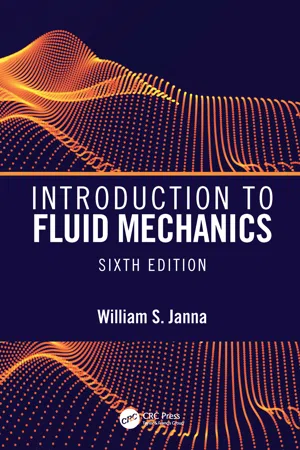
eBook - ePub
Introduction to Fluid Mechanics, Sixth Edition
William S. Janna
This is a test
Share book
- 734 pages
- English
- ePUB (mobile friendly)
- Available on iOS & Android
eBook - ePub
Introduction to Fluid Mechanics, Sixth Edition
William S. Janna
Book details
Book preview
Table of contents
Citations
About This Book
Introduction to Fluid Mechanics, Sixth Edition, is intended to be used in a first course in Fluid Mechanics, taken by a range of engineering majors. The text begins with dimensions, units, and fluid properties, and continues with derivations of key equations used in the control-volume approach. Step-by-step examples focus on everyday situations, and applications. These include flow with friction through pipes and tubes, flow past various two and three dimensional objects, open channel flow, compressible flow, turbomachinery and experimental methods. Design projects give readers a sense of what they will encounter in industry. A solutions manual and figure slides are available for instructors.
Frequently asked questions
How do I cancel my subscription?
Can/how do I download books?
At the moment all of our mobile-responsive ePub books are available to download via the app. Most of our PDFs are also available to download and we're working on making the final remaining ones downloadable now. Learn more here.
What is the difference between the pricing plans?
Both plans give you full access to the library and all of Perlego’s features. The only differences are the price and subscription period: With the annual plan you’ll save around 30% compared to 12 months on the monthly plan.
What is Perlego?
We are an online textbook subscription service, where you can get access to an entire online library for less than the price of a single book per month. With over 1 million books across 1000+ topics, we’ve got you covered! Learn more here.
Do you support text-to-speech?
Look out for the read-aloud symbol on your next book to see if you can listen to it. The read-aloud tool reads text aloud for you, highlighting the text as it is being read. You can pause it, speed it up and slow it down. Learn more here.
Is Introduction to Fluid Mechanics, Sixth Edition an online PDF/ePUB?
Yes, you can access Introduction to Fluid Mechanics, Sixth Edition by William S. Janna in PDF and/or ePUB format, as well as other popular books in Technik & Maschinenbau & Maschinenbau. We have over one million books available in our catalogue for you to explore.
Information
1 Fundamental Concepts
Fluid mechanics is the branch of engineering that deals with the study of fluids—both liquids and gases. Such a study is important because of the prevalence of fluids and our dependence on them. The air we breathe, the liquids we drink, the water transported through pipes, and the blood in our veins are examples of common fluids. Further, fluids in motion are potential sources of energy that can be converted into useful work—for example, by a waterwheel or a windmill. Clearly, fluids are important, and a study of them is essential to the engineer.
After completing this chapter, you should be able to:
- Describe commonly used unit systems;
- Define a fluid;
- Discuss common properties of fluids;
- Establish features that distinguish liquids from gases; and
- Present the concept of a continuum.
1.1 DIMENSIONS AND UNITS
Before we begin the exciting study of fluid mechanics, it is prudent to discuss dimensions and units. In this text, we use two unit systems: the British gravitational system and the international system (SI). Whatever the unit system, dimensions can be considered as either fundamental or derived. In the British system, the fundamental dimensions are length, time, and force. The units for each dimension are given in the following table:
British Gravitational System | ||
Dimension | Abbreviation | Unit |
Length | L | foot (ft) |
Time | T | second (s) |
Force | F | pound-force (lbf) |
Mass is a derived dimension with units of slug and defined in terms of the primary dimensions as
| (1.1) |
Converting from the unit of mass to the unit of force is readily accomplished because the slug is defined in terms of the lbf (pound-force).
Example 1.1
An individual weighs 150 lbf.
- a. What is the person’s mass at a location where the acceleration due to gravity is 32.2 ft/s2?
- b. On the moon, the acceleration due to gravity is one-sixth of that on earth. What is the weight of this person on the moon?
Solution
- a. Applying Newton’s law, we write
-
- Substituting gives
-
- Solving for mass, we obtain
-
- or
-
- b. The mass is the same on the moon as on the earth. Again we apply Newton’s law,
-
- where m = 4.66 slug and the acceleration due to gravity is
-
- Substituting, the wei...